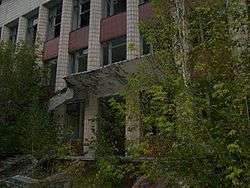Poliske
| Poliske Поліське | |
|---|---|
| Urban-type settlement | |
|
Abandoned administrative building, 2009 | |
 Poliske Location of Poliske in Ukraine | |
| Coordinates: 51°14′27.27″N 29°23′13.11″E / 51.2409083°N 29.3869750°ECoordinates: 51°14′27.27″N 29°23′13.11″E / 51.2409083°N 29.3869750°E | |
| Country |
|
| Oblast |
|
| Raion |
|
| Founded | 1415 |
| Population (2013) | |
| • Total | 20 |
| (ca 12,000 in 1986) | |
| Area code(s) | +380 4592 |



Poliske (Ukrainian: Поліське) or Polesskoye (Russian: Полесское) is an abandoned settlement and former town in the Chernobyl Exclusion Zone, part of Kiev Oblast, Ukraine. It is located on the Uzh River and was an administrative center of Poliske Raion (district). However, later the town was taken out of a registry as it was completely depopulated being located in the Zone of alienation. Currently around 10 people live there, so called samosely ("self-settlers").[1]
History
Overview
Originally called Khabnoye or Khabne' (Russian: Хабное, Ukrainian: Хабне), it was renamed Kaganovichi Pervye or Kahanovychi Pershi (Russian: Кагановичи Первые, Ukrainian: Кагановичі Перші) in 1934, and Poliske in 1957.
Founded in the 15th century, it was the home of the Polish family Horwatt from 1850 to 1918. In the 19th century this small city was known for its weavers and its textile industry. In 1890, 80% of the population was Jewish. In the later half of the 19th century, and in the beginning of the 20th century, there was known a klezmer band of Makonowiecki family. Khabne lost all its major architecture during the Soviet Union - the castle of Radziwiłł, Orthodox churches, and the Catholic Church. In 1938, Khabne received official city status. After the Chernobyl disaster, Khabne's population started to fall off. In 1999, the remaining population was evacuated. In 2005 there were about 1000 people still living there, mostly senior citizens.[2]
Abandonment
Following the Chernobyl Nuclear Power Plant accident, a Zone of Alienation (Ukrainian: Зона відчуження Чорнобильської АЕС, zona vidchuzhennya Chornobyl's'koyi AES), also known as the Chernobyl Exclusion Zone, the 30 Kilometre Zone, or simply The Zone (Ukrainian: Чорнобильська зона, Chornobyl's'ka zona) was designated by the USSR military after the 1986 disaster.[3] Initially, 30 km radius area was evacuated and placed under military control, however, over time the borders of the Zone of Alienation have increased to cover a larger area of contamination.[4] The zone is now approximately 2,600 km² (1,000 sq miles), where radioactive fallout contamination is highest.[5] Public access and inhabitation is restricted due to radiological hazards and allow for ecological monitoring by environmental scientists.[6] Ten "self settlers" have remained in the nuclear ghost town.
Geography
Located in the north-western corner of Kiev Oblast, at the borders with Zhytomyr Oblast, Poliske is part of the natural region of Polesia, and is 27 km from the Belarusian border. Crossed by the regional highway P02 Ovruch-Kiev (135 km south), the town lies between Vilcha (17 km north) and Krasiatychi (27 km south). It is 41 km far from Narodychi, 53 from Ovruch and Ivankiv, 58 from Pripyat and 65 from Chernobyl.[7]
Notable people
- Iser Kuperman, a seven-time world champion of draughts, was born in Khabne on April 21, 1922.
- Lazar Kaganovich, one of leaders of the Soviet Union, and co-author of The Ukrainian Famine and Katyn massacre was born in the suburb of Kabany (Russian: Кабаны, Кабани, Кабанив) (near Khabne) in 1893.
In popular culture
- In S.T.A.L.K.E.R.: Shadow of Chernobyl is a cut location called Dead City and appears to draw inspiration from Poliske.
See also
References
- ↑ Herbaut, Guillaume. "Poliske: The Forgotten City of Chernobyl". Retrieved 6 February 2015.
- ↑ Marples, David Roger (1986). Chernobyl and Nuclear Power in the USSR. CUIS Press. ISBN 978-0920862506. Retrieved 6 February 2015.
- ↑ Petryna, Adriana (2002). Life Exposed: Biological Citizens after Chernobyl. New Jersey: Princeton University Press. ISBN 978-0-691-09019-1.
- ↑ Marples, David R. (1988). The Social Impact of the Chernobyl Disaster. New York: St. Martin's Press. ISBN 0-312-02432-0.
- ↑ Mould, R. F. (2000). Chernobyl Record: The Definitive History of the Chernobyl Catastrophe. Bristol, UK: Institute of Physics Publishing. ISBN 0-7503-0670-X.
- ↑ Bondarkov, Mikhail D.; Oskolkov, Boris Y.; Gaschak, Sergey P.; Kireev, Sergey I.; Maksimenko, Andrey M.; Proskura, Nikolai I.; Jannik, G. Timothy (2011). Environmental Radiation Monitoring in the Chernobyl Exclusion Zone - History and Results 25 Years After. Georgia: US: Savannah River National Laboratory.
- ↑ 50426438 Poliske on OpenStreetMap
External links
![]() Media related to Poliske at Wikimedia Commons
Media related to Poliske at Wikimedia Commons
